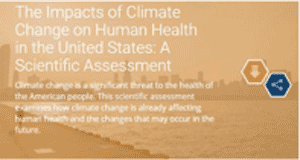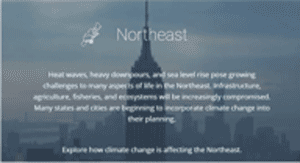Climate and Health Profiles |
DPH is implementing the steps of the Centers for Disease Control and Prevention (CDC's) Building Resilience Against Climate Effects (BRACE) framework to support local health efforts to prepare for the health implications of climate change.
Climate projections in the Northeast US predict:
- frequency, intensity, and duration of heat waves are expected to increase, including many more days per year above 90°F compared to the end of last century
- frequency, intensity, and duration of cold air outbreaks are expected to decrease as the century progresses
- global sea levels are projected to rise 1 to 4 feet by 2100 depending in large part on the extent to which the Greenland and West Antarctic Ice Sheets experience significant melting. Sea level rise of two feet, without any changes in storms, would more than triple the frequency of dangerous coastal flooding throughout most of the Northeast
- frequency of heavy downpours is projected to continue to increase as the century progresses
- seasonal drought risk is also projected to increase in summer and fall as higher temperatures lead to greater evaporation and earlier winter and spring snowmelt
- the region’s populations, infrastructure, agriculture, and ecosystems are vulnerable to extreme weather events and associated coastal and/or inland flooding
The Climate Hazard Adaption Profiles (CHAPs) provide information about climate hazards, human exposure and health impacts, vulnerable populations, and available resources for taking actions to protect health.
- Extreme Heat and Poor Air Quality
- Sea Level Rise
- Inland Flooding
- Extreme Weather
- Recreational Water Quality
The table below provides examples of climate impacts on human health.
| Climate Driver | Exposure | Health Outcome | Impact | |
|---|---|---|---|---|
| Extreme Heat | Climate Driver More frequent, severe, prolonged heat events | Exposure Elevated temperatures | Health Outcome Heat-related death and illness | Impact Rising temperatures will lead to an increase in heat-related deaths and illnesses |
| Outdoor Air Quality | Climate Driver Increasing temperatures and changing precipitation patterns | Exposure Worsened air quality (ozone, particulate matter, and higher pollen counts) | Health Outcome Premature death, acute and chronic cardiovascular and respiratory illnesses | Impact Rising temperatures and wildfires and decreasing precipitation will lead to increases in ozone and particulate matter, elevating the risks of cardiovascular and respiratory illnesses and death. |
| Flooding | Climate Driver Rising sea level and more frequent or intense extreme precipitation, hurricanes, and storm surge events | Exposure Contaminated water, debris, and disruptions to essential infrastructure | Health Outcome Drowning, injuries, mental health consequences, gastrointestinal and other illness | Impact Increased coastal and inland flooding exposes populations to a range of negative health impacts before, during, and after events |
| Vector-Borne Infection (Lyme Disease) | Climate Driver Changes in temperature extremes and seasonal weather patterns | Exposure Earlier and geographically expanded tick activity | Health Outcome Lyme disease | Impact Ticks will show earlier seasonal activity and a generally northward range expansion, increasing risk of human exposure to Lyme and disease-causing bacteria. |
| Water-Related Infection (Vibrio vulnificus ) | Climate Driver Rising sea surface temperature, changes in precipitation, and runofff affecting coastal salinity | Exposure Recreational water or shellfish contaminated with Vibrio vulnificus | Health Outcome Vibrio vulnificus induced diarrhea & intestinal illness, wound and bloodstream infections, death | Impact Increases in water temperatures will alter timing and location of Vibrio vulnificus growth, increasing exposure and risk of water-borne illness. |
| Food-Related Infection (Salmonella) | Climate Driver Increases in temperature, humidity, and season length | Exposure Increased growth of pathogens, seasonal shifts in incidence of Salmonella exposure | Health Outcome Salmonella infection, gastrointestinal outbreaks | Impact Rising temperatures increase Salmonella prevalence in food, longer seasons and warming waters increase risk of exposure and infection. |
| Mental Health and Well-Being | Climate Driver Climate-change impacts, especially extreme weather | Exposure Level of exposure to traumatic events, like disasters | Health Outcome Distress, grief, behavioral health disorders, social impacts, resilience | Impact Changes in exposure to climate- or weather-related disasters cause or exacerbate stress and mental health consequences, with greater risk for certain populations. |
|
Source: US Global Change Research Program, 2016. The Impacts of Climate Change on Human Health in the United States: A Scientific Assessment. Crimmins, A., J. Balbus, J.L. Gamble, C.B. Beard, J.E. Bell, D. Dodgen, R.J. Eisen, N. Fann, M.D. Hawkins, S.C. Herring, L. Jantarasami, D.M. Mills, S. Saha, M.C. Sarofim, J. Trtanj, and L. Ziska, Eds. U.S. Global Change Research Program, Washington, DC, 312 pp. |
||||
Specific information on climate hazards and projected health impacts in Massachusetts is provided in the Massachusetts Climate Change Adaptation Report. More detailed information from comprehensive, evidence-based scientific reports is available in the U.S. Global Change Research Program (USGCRP 20161) Climate and Health Assessment and the Northeast region chapter of the National Climate Assessment (Horton et al., 20142).

|

|
1 USGCRP, 2016. The Impacts of Climate Change on Human Health in the United States: A Scientific Assessment. Crimmins, A., J. Balbus, J.L. Gamble, C.B. Beard, J.E. Bell, D. Dodgen, R.J. Eisen, N. Fann, M.D. Hawkins, S.C. Herring, L. Jantarasami, D.M. Mills, S. Saha, M.C. Sarofim, J. Trtanj, and L. Ziska, Eds. U.S. Global Change Research Program, Washington, DC, 312 pp.
2 Melillo, Jerry M., Terese (T.C.) Richmond, and Gary W. Yohe, Eds., 2014: Climate Change Impacts in the United States: The Third National Climate Assessment. U.S. Global Change Research Program, 841 pp
